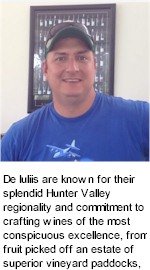


Originating from Italy the De Iuliis family have made the Hunter region their home since 1960. After a long successful career in the Hunter mining industry, Joss and Anna De Iuliis were inspired to follow their family passion for wine and chose a property in the Lovedale Road region of the Lower Hunter Valley, converting a grazing property into a 20ha vineyard with the first vines planted in 1990. For the first decade they provided fruit for some of the Hunter Valley’s biggest names. It wasn't until their son Michael finished his postgraduate studies in Oenology at the world renowned Roseworthy campus (Adelaide University) in 1999 with remarkable results that dynamic of the business changed from grape growing to wine production.

Michael De Iuliis, well known and well liked Hunter Valley winemaker and wine judge, started off as a Macquarie university Science Graduate and completed post Graduate studies in Oenology at Roseworthy Campus (Adelaide University) in 1999. The year after saw his first complete vintage as a winemaker, using grapes grown on the De Iuliis family vineyard. Since then he has gained a huge reputation for his fresh approach to creating wines truly expressive of his home Hunter region which are considered as some of the best examples coming from the Hunter Valley.
Today, De Iuliis wines are known for their trademark Hunter regionality and commitment to showcasing the very best the Hunter Valley has to offer. The Australian Wine Companion by James Halliday has been rating De Iuliis Wines a 5 star winery since 2010. The family’s vision is to continue producing wines of excellence and outstanding quality from individual paddocks, wines of distinction which they are proud to have their name on.
The Lovedale Road property was purchased by Joss and Anna De Iuliis in 1987 and after several years of soil preparation the first vines were planted in 1990. The soil type on the land is clay loam over friable red clay. The first varieties planted were Chardonnay and Semillon, in 1991 Verdelho, Merlot and Shiraz. The first vintage was in 1992, where a small amount of Semillon and Chardonnay was picked by the family and friends.
Among many accolades, Michael has been a Len Evans Tutorial Scholar (2004) as well as Finalist at the Young Winemaker of the Year Awards (The Wine Society, 2005). Michael was one of 8 Nominees for the 2013 Gourmet Traveller Wine Winemaker of the Year Award. A new state of the art winery and a modern airy cellar door was built, designed by architect Lionel Glendenning, completed just in time for vintage 2001.
Michael De Iuliis has completed the Future Leaders Program (Winemakers’ Federation of Australia, 2009) which led to his further involvement in other areas of the Australian wine industry such as wine show judging and his active part in the Hunter Valley community, promoting the wine region as a whole at numerous events around Australia. His involvement includes the Next Generation Hunter Valley, Pokolbin Reds Rugby team, the Cessnock Council and the Hunter Valley Wine and Tourism Association. Presently there is an average yearly crush of approximately 100 tonnes from the 15 hectares of vineyard. The low yield results in very concentrated fruit, which in turn, produces wine of exceptional flavour.
The De Iuliis Cellar Door is the heart of the De Iuliis boutique winery in beautiful Hunter Valley. A collaboration of art and engineering in design, architect Lionel Glendenning created a modern building that provides the perfect atmosphere to sample the fine wines. Framed by the iconic Brokenback mountain range, the landmark Cellar Door is spacious and filled with natural light. The floor-to-ceiling windows and an outdoor deck invite you to soak up Wine Country experience with views of manicured gardens and native fauna including resident kangaroos. The more adventurous might like to climb the observation tower for breathtaking views of the surrounding area.